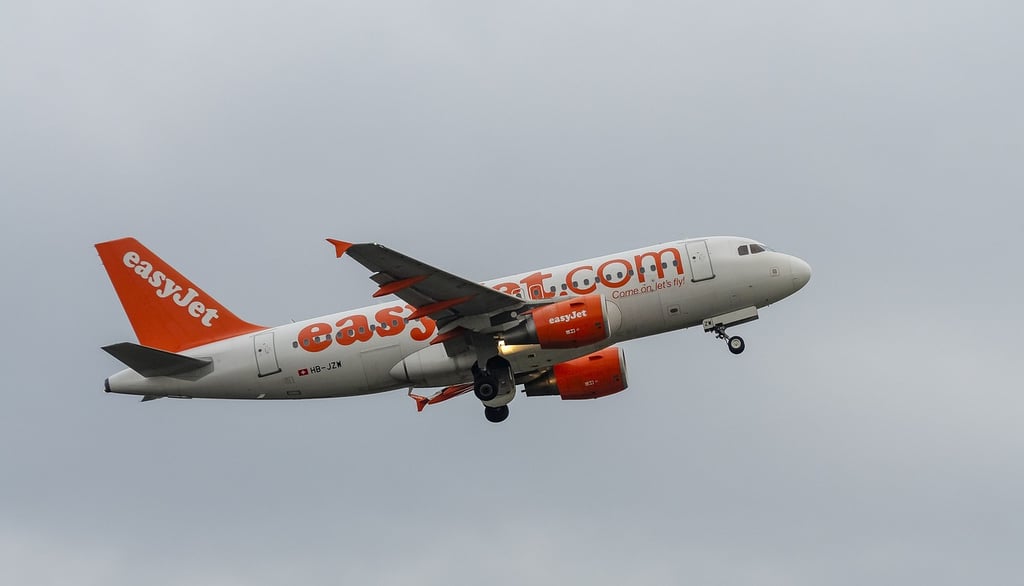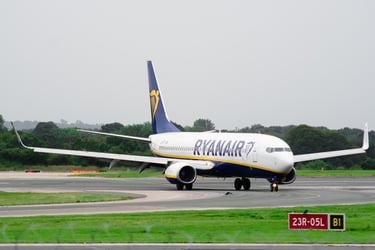Top 10 Cheapest European Airlines for Budget Travel in 2025
Many travelers look for affordable ways to explore Europe without sacrificing comfort or convenience. If you want to maximize your travel budget, knowing which airlines offer the best deals is important. This guide highlights the top 10 cheapest European airlines in 2025, helping you find reliable options that fit your itinerary and wallet. Whether you're planning quick city breaks or longer adventures, you’ll discover carriers that provide excellent value, so your money goes further while enjoying your journey across the continent.
8/6/20257 min read


The Rise of Low-Cost Carriers in Europe
Europe's aviation scene transformed drastically in the past two decades thanks to the rapid expansion of low-cost carriers (LCCs). Airlines like Ryanair and EasyJet challenged traditional flag carriers by offering no-frills service at significantly reduced fares. This shift has opened up unprecedented travel opportunities, allowing you to visit multiple destinations across the continent on a budget you control. The growing accessibility of budget flights has reshaped how you plan trips, making spontaneous weekend city breaks or multi-country tours more achievable than ever before.
Historical Context: The Birth of Budget Airlines
The low-cost airline model took off in Europe during the 1990s, inspired by Southwest Airlines in the United States. Ryanair’s early adoption of strict cost-cutting measures and point-to-point routes around 1994 was a key milestone. Deregulation in the EU aviation market enabled these budget pioneers to compete freely, breaking the stronghold of national carriers. You benefit today from decades of intense competition that has driven prices down and democratized air travel across the continent.
Market Dynamics: Supply, Demand, and Pricing Strategies
Budget airlines optimize pricing by leveraging variable demand patterns, often filling seats with strategically timed flash sales and dynamic fare structures. Capitalizing on secondary airports with lower fees helps keep your ticket costs minimal. You’ll notice that mid-week and off-peak flights often provide the best deals due to lower demand, while peak times see price surges. Airlines balance supply through fleet utilization, sometimes employing a "leisure-first" schedule that maximizes load factors on various route segments.
Delving deeper, these carriers use sophisticated revenue management systems that constantly adjust prices based on booking windows, competitor pricing, and historical data. For example, Ryanair often releases a limited number of seats at €9.99 to create buzz, then gradually increases fares as flight dates approach, incentivizing early booking. This pricing dance benefits you if you monitor flights regularly and act fast. Additionally, ancillary revenue streams like baggage fees and seat selection offset low base fares, enabling airlines to sell ultra-cheap tickets while maintaining profitability.
Ranking the Top 10 Cheapest Airlines for 2025
Your budget travel plans in Europe can take off smoothly when you choose the right airline. This ranking draws from data on ticket prices, ancillary fees, and seasonal promotions to identify the top 10 airlines offering the best value in 2025. Airlines like Ryanair and easyJet remain front-runners due to their extensive route networks and discount strategies, while emerging carriers such as Wizz Air expand your options with competitive rates. Balancing affordability and service, this list helps you pinpoint where you can fly without stretching your budget too thin.
Evaluating Cost-Effectiveness: Key Metrics and Criteria
To gauge which airlines deliver the best value, ticket price is just the starting point. You’ll want to consider baggage fees, seat selection costs, and onboard amenities that might add extra charges. Flight frequency and route diversity also impact how reliably you can find affordable options. Comparing how these factors stack up allows you to differentiate between airlines that appear cheap and those genuinely delivering savings on your total travel spend.
A Closer Look at Each Airline: Unique Offerings and Routes
Each airline on this list brings something distinct to the table, tailored to different traveler preferences. For example, Ryanair specializes in ultra-low fares and frequently serves secondary airports that keep costs down, while easyJet focuses on major hubs, providing more convenient connections. Wizz Air’s rapidly expanding presence in Eastern Europe opens up budget-friendly routes to lesser-explored destinations. Understanding these profiles lets you choose carriers that align with your itinerary and comfort needs.
Diving deeper, you’ll find that airlines like Vueling prioritize customer experience with complimentary snacks on certain routes, adding value beyond just low prices. Norwegian Air Shuttle offers competitive transcontinental flights between Europe and North America, giving you budget options beyond intra-European trips. Meanwhile, Pegasus Airlines features a robust network connecting Europe with the Middle East and Asia at attractive fares. Examining these unique service features and geographic footprints helps you tailor your travel plans precisely to your budget and destination goals.
Insider Tips for Maximizing Savings
Saving on budget flights goes beyond just picking the cheapest airline. Keep an eye on flash sales and subscribe to airline newsletters to catch limited-time deals. Flexibility with airport choices can shave off costs—flying from smaller regional airports often means lower fees. Using incognito mode during searches sometimes reveals better prices as fare algorithms might adjust based on your search history. Take advantage of airline bundles combining flights with accommodation or car rental for additional discounts. Any combination of these tactics can add up to significant savings over time.
The Best Times to Book and Travel
Booking your tickets about six to eight weeks ahead tends to yield the best prices, especially for European low-cost carriers. Flying midweek—Tuesdays and Wednesdays—can also result in cheaper fares, as demand dips. Early morning or late evening flights frequently offer the lowest prices, bypassing peak travel times. Avoiding school holidays and major European festivals helps you steer clear of surges in ticket prices. Planning your trip during the shoulder seasons, like late spring or early fall, maximizes affordability without sacrificing decent weather or flight availability.
Utilizing Loyalty Programs and Discount Offers
Signing up for budget airlines’ loyalty programs opens doors to exclusive discounts, rapid point accumulation, and early access to sales. For instance, Ryanair’s “Ryanair Choice” membership provides discounts on checked bags and priority boarding for a yearly fee, saving frequent flyers money. Many airlines partner with credit cards and travel apps, which can offer bonus points or cashback on flight bookings. You’ll also find targeted promo codes distributed through social media or email campaigns that can knock 10-20% off ticket prices. Combining these offers effectively boosts your overall savings.
Beyond the sign-up bonuses, loyalty programs frequently run tiered rewards allowing you to earn points not just on flights but on ancillary services like in-flight meals and seat upgrades. Airlines like Wizz Air reward recurrent travelers with “Wizz Discount Club” memberships that reduce fees on every trip for an annual fee. Tracking and optimizing your points balance using airline apps or third-party platforms empowers you to redeem flights or upgrades that minimize your out-of-pocket cost. Any strategic use of these programs multiplies your chances of landing ultra-cheap tickets across Europe in 2025.
Navigating the Challenges of Budget Travel
Budget airlines offer incredible savings, but you’ll often face trade-offs that require careful planning. Navigating less-flexible ticket policies, seating disruptions, and limited amenities demands a strategic approach to avoid unexpected stress. Staying informed about each airline’s unique rules and preparing for potential inconveniences will help you enjoy the journey without surprises. Learning to prioritize what matters most—whether that’s timing, cost, or convenience—allows you to maximize the advantages of budget travel while minimizing its downsides.
Hidden Fees and Understanding the Fine Print
Basic ticket prices frequently exclude importants like checked bags, seat selection, and even onboard refreshments. You’ll want to carefully study the fare conditions with carriers like Ryanair or Wizz Air, where add-ons can quickly inflate your total cost. For example, a €10 seat reservation fee or €30 for a 20kg checked bag may seem minor but add up fast on round-trip flights. Checking airline websites for updated fee structures and reviewing recent traveler experiences can save you from budget-busting surprises at checkout or the gate.
Preparing for Potential Trade-offs: Comfort vs. Cost
Sacrifices in comfort often accompany the lowest fares. Expect limited legroom, basic seats, and less leg space on popular European budget airlines. Flights might also feature smaller overhead bins and reduced in-flight service. Accepting these conditions eases the impact of flying with discount carriers, but for longer journeys, a modest upgrade might be worth the small price to prevent fatigue or discomfort.
Diving deeper, many budget airlines operate with a high-density seating model, squeezing 29-31 inches of pitch compared to 32-34 inches on traditional carriers. Small seats can make three-hour flights feel longer, especially if you're tall or traveling with children. Some travelers solve this by paying for priority boarding or extra legroom seats, which often come at a reasonable extra cost but enhance your comfort significantly. Weighing these options against your budget and trip length can transform your travel experience from merely economical to genuinely enjoyable without unnecessarily breaking the bank.
Future Predictions for Budget Air Travel in Europe
Budget air travel in Europe is set to evolve with a stronger emphasis on efficiency and passenger experience. Airlines will likely invest heavily in digital tools that personalize travel and streamline booking, check-in, and boarding processes, reducing wait times and operational costs. You can expect more dynamic pricing models driven by AI, offering tailored deals that adjust closer to your travel dates. Combine that with environmental policies pushing for cleaner, greener flight options, and you’ll find that your low-cost air travel choices will become not only cheaper but also more sustainable and tech-friendly.
Emerging Trends: Sustainability and Technological Innovations
Airlines are rapidly adopting sustainable fuels and electric propulsion prototypes to cut carbon emissions, responding to Europe's push for greener travel. You might notice more flights powered by biofuels or hybrid engines on budget carriers by 2025. Tech innovations like biometric boarding and AI-driven customer support are making your journey smoother and quicker. These advancements are designed to enhance your travel experience without inflating ticket prices, proving that eco-friendly travel and affordability can go hand in hand.
How Economic Factors May Shape Pricing in the Coming Years
Fuel prices, inflation rates, and fluctuating demand will heavily influence ticket costs. For example, airline fuel typically accounts for up to 30% of operating expenses, so volatility here directly affects your airfare. Economic recovery patterns from global crises and European regulatory changes might cause pricing to stabilize or spike unexpectedly. Perceiving these economic undercurrents can help you strategically plan and snag the best deals during your booking attempts.
Several economic factors will shape your airfares in the near future:
Fuel cost fluctuations due to geopolitical tensions or supply chain disruptions can rapidly increase operational expenses.
Changes in taxation and airport fees across EU countries might impact ticket pricing scales differently, depending on your departure or arrival city.
Rising inflation could pressure airlines to balance cost-cutting with maintaining service quality, influencing how budget carriers structure fares.
Perceiving travel demand shifts post-pandemic enables you to anticipate periods of higher or lower fare competitiveness.
Understanding these economic dynamics allows you to time your bookings and route choices wisely. For instance, if fuel prices spike unexpectedly in the latter half of 2025, airlines may push for earlier bookings or promote off-peak flights at discounted rates. Similarly, regulatory changes in emissions trading or airport charges could cause budget carriers to adjust fares or adopt new operational strategies affecting your travel budget directly. By staying informed, you can navigate these fluctuations to your advantage.
Monitoring regional economic policies helps you identify emerging travel hotspots where competition may drive fares down.
Airline alliances and mergers can influence pricing power, sometimes resulting in broader route options or bundled discounts for you.
Inflation’s impact on ancillary fees (baggage, seat selection) will be an crucial factor to watch to keep your overall trip affordable.
Perceiving these economic signals ensures you remain agile in choosing when and how to book your budget flights.
To wrap up
Upon reflecting on the top 10 cheapest European airlines for budget travel in 2025, you have a solid foundation to plan your affordable trips across the continent. By choosing airlines that offer quality service at lower prices, you can make your travel budget stretch further without sacrificing comfort. Whether you’re seeking short city breaks or longer adventures, these carriers provide you with valuable options to explore Europe economically and efficiently, ensuring you get the best value for your money while enjoying your journey.


Contact us
Copyright © 2025. Ralnoscape All rights reserved.
Destinations
Resources


Follow us
This website uses affiliate links which may earn a commission at no additional cost to you
